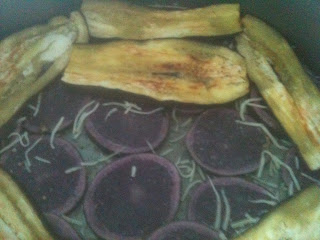Ancient Roman Tips by: Apicius vs.
today's tips by: Chef Alba
today's tips by: Chef Alba
To make vegetables bright green
Ancient Roman: All greens become bright green if boiled with cooking soda.
Today: To make vegetables retain their color even after cooking, cook vegetables in boiling salted water for a few minutes, then take them out and cool immediately in iced water (very cold water or water + ice cubes).
How to properly boil asparagus
Ancient Roman: Dry the asparagus plunge again into hot water; this will prevent them from getting too soft. Boiling of asparagus is interrupted; first they are only blanched, then dried, and put again into boiling water.
Today: Place the asparagus into salted boiling water. You really only need enough water to just cover the stalks. Boil for about 4-5 minutes and remove from the water promptly.
How to keep meat fresh without pickling
Ancient Roman: Cover meat that you wish to keep fresh with honey, but suspend the receptacle, and use when required. This is better in winter; in summer it will keep in this manner only a few days. You can use this method also with cooked meats.
Today: Place packaged meat in the coldest part of refrigerator. Be sure the refrigerator is 40 degrees F and the freezer temperature 0 degrees F. If placing in freezer, over wrap with freezer paper of plastic wrap prior to placing in freezer. Use meat placed in refrigerator within 2-3 days and meat placed in freezer within 2-3 months.
How to roast meat
Ancient Roman: Meat roasted plain in the oven, sprinkled with plenty of salt. Serve with honey. The honey brings out the flavor of the meat. Sauces were made later by pounding herbs, spices, and honey boiled with some corn flour to thicken.
Today: Before it goes into the oven, preheat the oven, trim the meat, season, and sear/brown it before placing into a baking dish for the oven. The standard temperature for cooking roasts is 350F degrees. Technically, the lower the heat of the oven, the better the final roasted product will be. At a lower temperature, the meat will take longer to cook but will produce more flavor and moisture. Never roast meat at a temperature below 200F degrees.
Keep Apples Fresh
Ancient Roman: Plunge them in boiling water, take out instantly, and hang up.
Today: Keep apples in the refrigerator in the vegetable bin. Remove any apples that may have bruises, cuts or are over ripe. These apples will release a gas that will cause the other apples to ripen too quickly. Wrap each apple in tissue paper then place in the refrigerator. This will delay the ripening process.
____________________________________________________



















